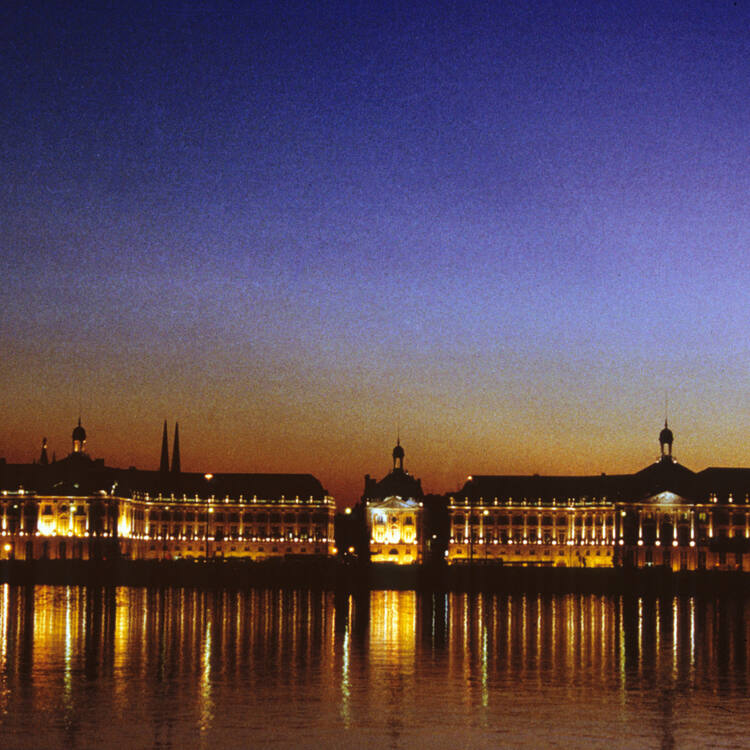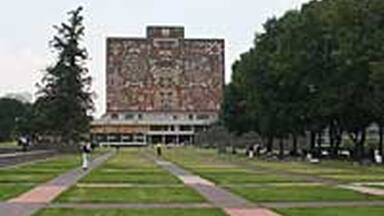Bordeaux, Port of the Moon
Bordeaux, Port of the Moon
The Port of the Moon, port city of Bordeaux in south-west France, is inscribed as an inhabited historic city, an outstanding urban and architectural ensemble, created in the age of the Enlightenment, whose values continued up to the first half of the 20th century, with more protected buildings than any other French city except Paris. It is also recognized for its historic role as a place of exchange of cultural values over more than 2,000 years, particularly since the 12th century due to commercial links with Britain and the Low Lands. Urban plans and architectural ensembles of the early 18th century onwards place the city as an outstanding example of innovative classical and neoclassical trends and give it an exceptional urban and architectural unity and coherence. Its urban form represents the success of philosophers who wanted to make towns into melting pots of humanism, universality and culture.
Description is available under license CC-BY-SA IGO 3.0
Bordeaux, Port de la Lune
Le centre historique de cette ville portuaire située dans le sud-ouest de la France représente un ensemble urbain et architectural exceptionnel, créé à l’époque des Lumières, dont les valeurs ont perduré jusqu’à la première moitié du XXe siècle. Paris exclu, c’est la ville française qui compte le plus de bâtiments protégés. Elle voit aussi reconnaître son rôle historique en tant que centre d’échanges d’influences sur plus de 2 000 ans, en particulier depuis le XIIe siècle du fait des liens avec la Grande-Bretagne et les Pays-Bas. Les plans urbains et les ensembles architecturaux à partir du début du XVIIIe siècle font de la ville un exemple exceptionnel des tendances classiques et néoclassiques et lui confèrent une unité et une cohérence urbaine et architecturale remarquables. Son urbanisme représente le succès des philosophes qui voulaient faire des villes un creuset d’humanisme, d’universalité et de culture.
Description is available under license CC-BY-SA IGO 3.0
بوردو، ميناء القمر
يشكل الوسط التاريخي لتلك المدينة المرفئية الواقعة في الجنوب الغربي لفرنسا مجمعاً حضرياً وهندسياً استثنائياً يعود إلى عصر الأنوار، بقيت قيمه قيد التداول حتى النصف الأول من القرن العشرين. إنها بعد باريس ثاني المدن الفرنسية من حيث عدد المباني المحافظ عليها التي تأويها. ولقد امتد دور بوردو التاريخي كمركز لتقلب النفوذ أكثر من 2000 عام، لاسيما منذ القرن الثاني عشر بسبب العلاقات مع بريطانيا العظمى وهولندا. منذ مطلع القرن الثامن عشر، ساهمت المخططات المدنية والمجموعات العمرانية في تحويل المدينة إلى مثال رائع للاتجاهات الكلاسيكية والنيوكلاسيكية يعكس وحدة وانسجاماً معماريين عاليين. ويشير تنظيم المدينة إلى نجاح الفلاسفة في جعل المدن بوتقة إنسانية ومكانا لكونية الثقافة وشموليتها.
source: UNESCO/CPE
Description is available under license CC-BY-SA IGO 3.0
波尔多月亮港
作为历史中心的波尔多,人称“月亮港”,是位于法国西南的一座港口城市,建立于启蒙运动时期,汇集了大量城市建筑,其价值观念一致延续到20世纪前半叶。这里作为历史古城列入世界遗产,除巴黎外,这里是法国受保护建筑最多的城市。2000多年来,特别是从12世纪开始同英国和低地国家开展商业往来以来,月亮港作为文化价值交流中心发挥了重要的历史作用。18世纪初期以来的城市规划和建筑群体现了创造性古典主义和新古典主义趋势,展示了城市与建筑的完美结合与统一。这里的城市布局是哲学家的胜利,他们把城市变成了人文主义、普遍性和文化的融炉。
source: UNESCO/CPE
Description is available under license CC-BY-SA IGO 3.0
Порт Луны
Этот исторический центр города-порта на юго-западе Франции является уникальным городским и архитектурным ансамблем эпохи Просвещения, идеалы которой были актуальны до первой половины XX в. Бордо - второй после Парижа город Франции по количеству охраняемых государством памятников истории. На протяжении более 2 000 лет он играл важную роль в отношениях и обменах между разными странами особенно с XII в. – между Великобританией и Нидерландами. С начала XVIII в. градостроительные и архитектурные планы создают здесь уникальный ансамбль классицизма и неоклассицизма, придавая городу неповторимую урбанистическую гармонию. Градостроительный облик Бордо отражает идеалы философов, мечтавших превратить города в очаги гуманизма, культуры, обменов духовными идеалами.
source: UNESCO/CPE
Description is available under license CC-BY-SA IGO 3.0
Centro histórico de Burdeos - Puerto de la Luna
El centro histórico de esta ciudad portuaria del sudoeste de Francia posee un conjunto urbanístico y arquitectónico excepcional creado en el Siglo de las Luces, cuyos valores han perdurado hasta la primera mitad del siglo XX. Burdeos es, después de París, la ciudad francesa con más monumentos históricos protegidos. Fue un centro de intercambios culturales a lo largo de más dos milenios, sobre todo a partir del siglo XII, época en la que se estrecharon sus vínculos con la Gran Bretaña y los Países Bajos. El trazado urbano y los conjuntos de edificios construidos desde principios del siglo XVIII no sólo hacen de esta ciudad un ejemplo excepcional de la arquitectura neoclásica, sino que además le confieren una coherencia y unidad extraordinarias. El urbanismo de Burdeos refleja el triunfo de los ideales de los filósofos del Siglo de las Luces, que aspiraban a hacer de las ciudades verdaderos crisoles del humanismo, la universalidad y la cultura.
source: UNESCO/CPE
Description is available under license CC-BY-SA IGO 3.0
ボルドー、リューヌ港
ボルドーはフランス南西部の中心都市である港町。フランス語で「月」を意味する「リューヌ」港の名は、湾曲するガロンヌ河岸に発達した町の形状に由来する。この町はローマ帝国の植民地となった紀元前56年以降に発展をはじめ、12世紀後半には世界有数のワイン生産地として、イングランドやスコットランドなどと貿易を行う一大商業都市となった。現在もボルドーには、起源が3世紀までさかのぼる建造物が残り、なかでも重要なのは、18世紀の啓蒙主義時代の都市計画による町並みだ。1730年代に建設が始まった王国広場や宮殿、1780年建造の大劇場など、建造物の多くは古典様式や新古典様式である。source: NFUAJ
Bordeaux, haven van de maan
Bordeaux, de haven van de maan, is de bewoonde historische stad, gesticht tijdens de periode van de Verlichting, waarvan de waarden tot de eerste helft van de 20e eeuw invloed hadden. De havenstad heeft meer beschermde gebouwen dan enige andere Franse stad, behalve Parijs. Bordeaux wordt gewaardeerd vanwege zijn historische rol als uitwisselingsplaats van culturele waarden gedurende meer dan 2.000 jaar, met name sinds de 12e eeuw dankzij commerciële banden met Groot-Brittannië en de Lage Landen. Het stadsontwerp weerspiegelt het succes van filosofen die steden wilden veranderen in smeltkroezen van humanisme, universaliteit en cultuur.
Source: unesco.nl
Outstanding Universal Value
Bordeaux, Port of the Moon, is an outstanding example of the exchange of human values over more than two thousand years, due to its role as capital city of a world-famous wine production region and the importance of its port in commerce at regional and international levels. The urban form and architecture of the city are the result of continuous extensions and renovations since Roman times up to the 20th century. Urban plans and architectural ensembles stemming from the early 18th century onwards place the city as an outstanding example of classical and neo-classical trends and give it an exceptional urban and architectural unity and coherence.
Criterion (ii): Bordeaux, Port of the Moon, constitutes an exceptional testimony to the exchange of human values over more than two thousand years. These exchanges have provided this cosmopolitan town, in the age of Enlightenment, an unparalleled prosperity that provided for an exceptional urban and architectural transformation that continued through 19th century up to present time. The different stages of construction and development of the harbour town are legible in its urban plan, especially the big transformations carried out from the early 18th century onwards.
Criterion (iv): Bordeaux, Port of the Moon, represents an outstanding urban and architectural ensemble, created in the Age of Enlightenment, whose values have continued up to the first half of the 20th century. Bordeaux is exceptional in the unity of its urban and architectural classical and neo-classical expression, which has not undergone any stylistic rupture over more than two centuries. Its urban form represents the success of philosophers who wanted to make towns into melting pots of humanism, universality and culture.
Due to its port, the city of Bordeaux has retained its original functions since its creation, as a city of exchange and commerce. Its history is easily legible in its urban plans from the Roman castrum to the 20th century. The city has retained its authenticity in the historic buildings and spaces created in the 18th and 19th centuries.
The City of Bordeaux has 347 listed buildings, referred to the law of 31 December 1913. The historic town is protected by the “Plan de sauvegarde et de mise en valeur” (PSMV), approved in 1988 and revised in 1998 and 2002. A buffer zone has been established. Management structures for the protection and conservation of the nominated property include the shared responsibilities of national, regional and local governments. Interventions on buildings declared Monuments historiques (classés) must have the support of the Ministry for Culture. Several plans ensure the management and conservation of the property and take into account the following aspects: preserving the historic and heritage character, allowing the controlled evolution of the historic centre, unifying the various planning rules and contributing to the international significance of metropolitan Bordeaux.





